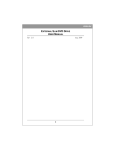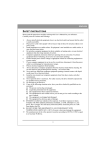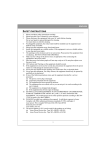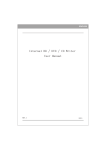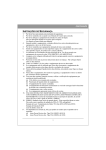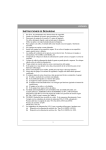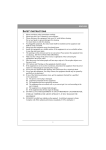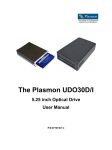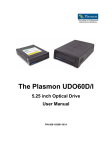Download Lite-On iHES208
Transcript
ENGLISH SAFETY INSTRUCTIONS Please read all instructions carefully and keep this User’s Manual for your reference. Carefully note all Cautions and Warnings. 1. 2. 3. 4. 5. 6. 7. 8. 9. 10. 11. 12. 13. 14. 15. 16. 17. Always install electrical equipment close to an electrical outlet and ensure that the outlet is easily accessible. Place power cords where people will not step or trip on them. Do not place objects over power cords. Install equipment on a stable surface. If equipment is not installed on a stable surface, it may drop and cause injury. Do not place computer equipment in direct sunlight, on heating units, or near electrical appliances that draw large amounts of current. Computer equipment enclosures often have openings for air convection. To protect equipment from overheating, do not cover air convection openings. Ensure that the power source voltage is appropriate whenever connecting equipment to a power outlet. If your computer equipment is not in use for several days, disconnect it from the power outlet to avoid damage by transient power surges. Protect electrical equipment from humidity. Always disconnect computer equipment from the electrical outlet before cleaning. Do not use liquid or sprayed detergent for cleaning – use a moist cloth. Never pour any liquid into computer equipment openings; internal contact with liquid could cause fire or electrical shock. Keep the area around your computer equipment clean from dust, smoke, and other contaminants. Never open this drive’s enclosure. For safety reasons, the drive should be opened only by qualified service personnel. Do not drop or jolt the drive. If any of the following situations arise, have your drive checked by qualified service personnel: (a) The power cord or plug is damaged. (b) Liquid has penetrated into the equipment. (c) The equipment has been exposed to moisture. (d) The equipment has not worked well or you can not get it to work according to the user’s manual. (e) The equipment was dropped and damaged. (f) The equipment has obvious signs of damage. DANGER: Invisible laser radiation when opened. Avoid direct exposure to beam. Complies with FDA radiation performance standards, 21 CFR, subchapter J. Laser power: Wave Length: 783±3nm (CD); 658±3nm (DVD). Emission power: 0.7 mW. Laser diode: class 3b. DO NOT STORE THIS EQUIPMENT IN AN ENVIRONMENT WITH TEMPERATURE ABOVE 60 (140 ). Excessive heat may damage the equipment. The sound pressure level at the operator’s position according to IEC704-1:1982 is equal to or less than 70 dB (A). ℃ ℉ 1 ENGLISH FCC COMPLIANCE STATEMENT Note: This equipment has been tested and found to comply with the limits for a Class B digital device, pursuant to Part 15 of the FCC Rules. These limits are designed to provide reasonable protection against harmful interference in a residential installation. This equipment generates, uses, and can radiate radio frequency energy and, if not installed and used in accordance with the instructions, may cause harmful interference to radio communications. However, there is no guarantee that interference will not occur in a particular installation. If this equipment does cause harmful interference to radio or television reception, which can be determined by turning the equipment off and on, the user is encouraged to try to correct the interference by one of the following measures: Reorient or relocate the receiving antenna. Increase the separation between the equipment and receiver. Connect the equipment into an outlet on a circuit different from that to which the receiver is connected. Consult the dealer or an experienced radio/TV technician for help. FCC Caution: To assure continued compliance, (example – use only shielded interface cables when connecting to computer or peripheral devices). Any changes or modifications not expressly approved by the party responsible for compliance could void the user’s authority to operate this equipment. This device complies with Part 15 of the FCC Rules. Operation is subject to the following two conditions: (1) this device may not cause harmful interference, and (2) this device must accept any interference received, including interference that may cause undesired operation. 2 ENGLISH PRECAUTIONS CAUTION: Do not attempt to open the drive for service. Removing the cover may cause exposure to harmful laser beams and electrical voltage. To obtain service, return the defective drive to the vendor where the drive was purchased. • Use the original package for transporting the drive or sending it back for service. The original packaging was designed and tested to protect your drive under rough conditions. • Keep your discs clean. Using a soft, dust-free cloth to clean the disc surface before recording will improve data integrity. • The copyright laws of each country govern the reproduction of copyrighted works. The person using this drive may be liable if it is used to make unauthorized copies of copyrighted works. • It will increase the success rate for copying the data from HDD, instead of copying the data by "copy on the fly mode". Therefore we recommend the user reserving sufficient buffer space for creating an image file (At least 650MB for CD; 5GB for DVD; and if your drive supports Double Layer DVD+R or Dual Layer DVD-R writing, then at least 9GB space is needed.) 3 ENGLISH TABLE OF CONTENTS INTRODUCTION What You Can Do with the BD Combo Drive……………………...………………5 Format Compatibility………………………………………………..………………6 Recording Modes Supported……………………………………...…………………6 System Configuration System Requirements……………………..…………………………………………7 Features and Controls Front View………………………………..…………………………………………8 Rear View……………………………………….…………………………………9 INSTALLATION Hardware Installation of Serial ATA Drives………………………..…. ...10 OPERATION Installing Device Driver and Software………………………………………11 Loading and Unloading the Tray………………………………………………11 Recording & Playing Recording CDs & DVDs ….………………..………………………………………12 Playing DVDs & BDs…………………….…………………………………………12 Playing Regionally Encoded DVDs…………………………...……………………12 About Software & Manuals…………………………………………………………12 Recommended Recordable & ReWritable Media………………………13 LightScribe User Guide How to Use LightScribe………………………………….…………………………14 Creating and Burning LightScribe-labeled Discs………...…………………………15 Frequently Asked Questions about LightScribe……………………….……………16 TROUBLESHOOTING Read Problems………………………………......…………………………………17 Write Problems………………………………………….…………………………19 4 ENGLISH INTRODUCTION This BD ( Blu-ray Disc ) Combo Drive provides professional-quality BD, DVD and CD performance for writing, rewriting and reading. It supports Running OPC (ROPC) and is compatible with Windows Plug & Play. In addition, the drive is equipped with buffer underrun technology to eliminate buffer underrun errors, so you can safely use your computer for other things while you’re writing to DVD or CD, and using a web connection, you can update this drive’s flash memory to the latest firmware revisions without opening the drive. NOTE: The drive’s maximum write, rewrite and read speeds are noted on the original package. What You Can Do with the BD Combo Drive Record data onto recordable or rewritable DVDs or CDs. Save photos and other images on recordable or rewritable DVDs or CDs. Record digital video or slide shows onto DVD+R, DVD+RW, DVD-R, and DVD-RW discs. Archive images and video to DVDs or CDs. Play BD-ROM, BD-R (BD Recordable), BD-RE (BD Rewritable), DVD-ROM, DVD+R, DVD+RW, DVD-R, and DVD-RW discs. Play music CDs. Play VCD, DVD and BD movies. Access interactive reference materials stored on DVDs & BDs. Create and burn LightScribe-labeled discs BD functions: Read BD-ROM, BD-R SL, BD-R DL, BD-RE SL and BD-RE DL media DVD functions: Write to DVD+R and DVD-R (recordable DVD) media Write to DVD+RW and DVD-RW (re-writable DVD) media Read DVD-ROM, DVD+R, DVD-R, DVD+RW, DVD-RW, DVD+R9 and DVD-R9 discs. Write to double-layer DVD+R (recordable DVD+R9) and dual-layer DVD-R (recordable DVD-R9) media Read or write to DVD-RAM media CD functions: Write to CD-R (recordable CD) media Write to ultra-speed CD-RW (rewritable CD) media Read CD-ROM and CD-R data media, and CD-RW and CD-DA (audio) media 5 ENGLISH Format Compatibility BD read: BD-ROM Version 2.0, BD-R Version 2.0/3.0, BD-RE Version 2.0/3.0, BD hybrid(BD part) and BD-9. DVD write: DVD+R Version 1.3, DVD+R9 Version 1.0, DVD-R9 Version 3.0, DVD+RW Version 1.3, DVD-R Version 2.1, and DVD-RW Version 1.2, DVD-RAM Version 2.2 DVD read: DVD-ROM single/dual layer (PTP, OTP), DVD-R, DVD+R, DVD+R9, DVD-R9, DVD-RW, DVD+RW, DVD-RAM CD write: Orange Book Part 2 CD-R Volume 1, Part 2 CD-R Volume 2 Multi Speed, Part 3 CD-RW Volume 1 Low Speed, Part 3 CD-RW Volume 2 High Speed, Part 3 CD-RW Volume 3 Ultra Speed CD read: CD-DA, CD-TEXT, CD-ROM Mode-1, CD-ROM/XA Mode-2 Form-1 and Form-2, Photo-CD, Multi-session, Karaoke-CD, Video CD, CD-I FMV, Enhance CD, CD Extra, UDF(fixed/variable Packet mode), CD Plus, CD-R, and CD-RW Recording Modes Supported Track at Once Data can be recorded to disc one track at a time. New tracks can be added later. This mode requires the disc to be “closed” (through the software application) before music CDs can be played back in a CD player or CD-ROM drive. Disc at Once Data can be recorded to an entire disc in one pass. In this mode, new data can not be added later. Session at Once Data can be recorded to a disc one session at a time. In this mode, new sessions can be written later. This mode allows more disc space to be used than multi-session mode allows, because no gap is created between sessions. Multi Session Data can be recorded to a disc in one session. In this mode, new sessions can be written later. This mode allows less disc space to be used than session-at-once mode allows, because a gap is created between sessions. Packet Writing Data can be added directly to or deleted from rewritable media. (Useful for data backup.) This mode requires software that supports packet writing. 6 ENGLISH SYSTEM CONFIGURATION System Requirements To ensure stable read/write/rewrite performance, a Windows-based PC system with the following features is required. CPU Operating System Memory Hard Drive Interface Pentium 4 2.0GHz or faster Microsoft Windows 2000 SP4 / Windows XP SP2 / Windows Vista 512MB or higher RAM Minimum 10GB available capacity Available Serial ATA (SATA) interface connector For High Definition BD Movie Playback: CPU Operating System Memory Hard Drive Display Devices for Digital Output Pentium D 3.0GHz or faster Microsoft Windows XP SP2 / Windows Vista 1GB or higher RAM Minimum 10GB available capacity HDCP capable monitor or TV HDCP capable graphics card with 256MB RAM, PCI Express x16, 1920x1200 resolution, 32bit color GPU Requirements: Support DXVA decoding for MPEG2 High Definition Video, Support DXVA decoding for H.264 High Definition Video, Support decoding 2 DXVA streams simultaneously (these 2 streams may in different format), Blending 3 High Definition (1920x1080) ARGB32 texture less than 3ms, Support HDCP for DVI / HDMI output via COPP Recommended GPU: NVIDIA GeForce 7600GT or above and ATI X1600 or above Graphics card drivers have to support HDCP standard *Remark: HDCP: High-bandwidth Digital Content Protection DXVA: Direct X Video Acceleration DVI: Digital Visual Interface HDMI: High Definition Multimedia Interface COPP: Certified Output Protection Protocol 7 ENGLISH FEATURES AND CONTROLS Front View Figure: Representative front view of BD drive (your drive may differ) A Eject / Close Button Push button to open or close the tray. B Indication of drive's operation status. When LED is on, the disc is loaded and ready; when blinking, the drive is reading / writing / rewriting or the disc is loading. On / Busy LED C Pin Hole Eject If the Eject button fails to work properly, insert a paper clip into this hole to open the tray. CAUTION: Turn off power to the drive before performing manual ejection. 8 ENGLISH Rear View For Serial ATA Drives: Figure: Rear view of Serial ATA drive Serial ATA Power Connector 15-pin connector for DC power input. Serial ATA Data Connector 7-pin connector for Serial ATA data interface. 9 ENGLISH HARDWARE INSTALLATION OF SERIAL ATA DRIVES 1. 2. 3. 4. 5. 6. 7. 8. Turn off your PC and disconnect all power cords. Refer to your PC user's manual to remove the PC cover. Find an empty bay, slide the drive into the bay and mount the drive by using 4 screws. Connect a Serial ATA data cable to the Primary or Secondary Serial ATA port on the motherboard or PCI card of your PC. Connect the other end of the Serial ATA data cable to your drive. NOTE: The pin definition of Serial ATA data cable connector should be the same as that in the following figure. (Optional) It may be necessary for you to use a 4-pin IDE to Serial ATA power adapter. It depends on the power connectors of your PC power supply. If one is required, attach this 4-pin to Serial ATA power adapter to the 4-pin power connector from your PC power supply. Connect the Serial ATA power connector to the power connector on the rear panel of your drive. NOTE: The Serial ATA power connector is larger than the Serial ATA data cable connector. And the pin definition of Serial ATA power connector should be the same as that in the following figure. Put the PC cover back and connect the power cords. Figure: Rear Panel of Serial ATA Drive 10 ENGLISH OPERATION Installing Device Drivers and Software Your Windows system already has device drivers that let you use the drive to install and set up software as soon as the drive is installed. However, to make use of all the drive’s features, such as writing to discs and playing commercially recorded movies, you need to install additional software. Loading and Unloading the Tray (1) While the BD drive is powered up, push the Eject button on the front panel to eject the tray. (2) Place a disc in the tray’s depression. To write to the data side, place the disc with the label side up. The disc should lie flat in the tray. Figure: Loading the Tray (3) Press the Eject button again to retract the tray. 11 ENGLISH RECORDING & PLAYING Recording CDs & DVDs To record CDs & DVDs, ensure that you have installed the proper software (see previous page). Playing DVDs & BDs To play commercially released movies on DVD or BD on this drive, you must have BD playback software installed on your PC. If you do not have BD playback software on your PC, or if you want to replace your BD playback software, install the appropriate application from the enclosed software CD (see previous page). Playing Regionally Encoded DVDs/BDs Some DVDs/BDs are encoded to be played in a certain region, such as North America or Europe. Your drive must be set to the correct region code to play these discs. No region code is preset when the BD drive is shipped. Instead, the first time a DVD/BD with a region setting is inserted into the BD drive, the act of inserting the DVD/BD sets the drive to that region code. If you later insert a DVD/BD with a different region code, you are prompted to accept a region code change. If you do not accept the change, the DVD/BD will not play. If you do accept the change, the BD drive’s region code setting is changed. NOTE: You may change the BD drive’s region code only 5 times. After that, you will not be able to change your drive’s code setting. (Your DVD/BD playback software will warn you if you approach the 5-change limit.) About Software & Manuals The detailed user’s manual for the recording and playback software is automatically installed on your computer when you install the software itself. 12 ENGLISH RECOMMENDED RECORDABLE & REWRITABLE MEDIA For consistent high quality, we recommend CD and DVD media from the following manufacturers (recommendations are subject to change without notice): CD-R Media: CMC, LEADDATA, MAXELL, MBI, MCC, LASMON, PRODISC, RITEK, Taiyo-Yuden Low Speed CD-RW Media: CMC, MKM, RICOH, RITEK High Speed CMC, LEAD DATA, MBI CD-RW Media: Ultra Speed CMC, MKM, RITEK CD-RW Media: DVD-R Media: CMC, DAXON, LEADDATA, MAXELL, MKM, PRODISC, RITEK, SONY, TDK, Taiyo-Yuden DVD-R9 Media: MKM, CMC, RITEK DVD-RW Media: CMC, JVC, MKM, RITEK, TDK DVD+R Media: CMC, MAXELL, MBI, MKM, PRODISC, RICOH, RITEK, SONY, TDK, Taiyo-Yuden DVD+R9 Media: MKM, Ritek, CMC DVD+RW Media: CMC, MBI, MKM, PHILIPS, RICOH, RITEK DVD-RAM Media: MAXELL, PANASONIC LightScribe Media CD-R: MKM, MBI, CMC DVD+R: MKM, MBI, CMC 13 ENGLISH LIGHTSCRIBE USER GUIDE The following LightScribe chapters are instruction for drives which support LightScribe disc labeling technology. Please refer to your drive’s original package to verify if your drive supports LightScribe disc labeling function. Figure: LightScribe Logos How to use LightScribe To label your CDs and DVDs with LightScribe, you need three components: A LightScribe-enabled drive LightScribe labeling software (included with your drive; other LightScribe-enabled applications are also available) LightScribe media (available where computers are sold) You can label your LightScribe disc before or after you burn the data side, and you can even label a number of discs in succession, whether or not you’ve already recorded data on them. The important thing to remember is to always insert your LightScribe disc label side down when burning your LightScribe. 14 ENGLISH CREATING AND BURNING LIGHTSCRIBE-LABELED DISCS 1. Start the LightScribe labeling software. Your labeling application may be part of your disc-burning software, or it may be a stand-alone application. 2. Choose the appropriate LightScribe setting(s) for your design. Most LightScribe-enabled labeling applications require you to select the “LightScribe” option before designing your label. 3. Create your label design. You can choose to create a label with text and/or graphics, and you can choose the area of the disc in which your label will be inscribed — from a simple band of text (“title only”) to a complete design that covers the entire disc (“full label”). Experiment with text, fonts, ready-made backgrounds, and your own photos and graphics to design the label that best suits your style. (For ideas and advice, visit www.lightscribe.com/labeltips) 4. When your design is ready, insert a blank LightScribe disc into the drive label side down. Before you can preview or print your design, the labeling application checks to see whether there’s a LightScribe disc inserted correctly in the drive; if there is no disc, or if your disc is not inserted with the LightScribe labeling side down, the software will send an error message. 5. Select the Preview option to see how your design will look as a LightScribe label. Previewing your design lets you determine whether the design elements are placed where you want them, and it shows you what the grayscale design will look like on disc. 6. Select the Print option to send the label design to disc. When you print your design to disc, you can choose from three quality modes: draft, normal, or best.“Draft” is the fastest printing mode, and the resulting design provides a lower level of contrast; “best” provides the highest contrast and darkest design areas, and the burning process takes longer. The following table shows a rough estimation of the expected print times. Setting Best Normal Draft 7. Title only <4 min. <3 min. <2 min. Title & content listing <9 min. <7 min. <4 min. Full label (with graphics) <36 min. <28 min. <20 min. When your label is finished, the drive will automatically eject your disc. 15 ENGLISH FREQUENTLY ASKED QUESTIONS Q: How does LightScribe work? A: The coating on a LightScribe disc changes color when it’s exposed to the CD/DVD drive’s laser. The process is similar to film exposure, except that the LightScribe surface reacts specifically to the intense light of the laser. Q: What happens if I try to use LightScribe to label a non-LightScribe disc? A: The software prevents you from sending a label image to a non-LightScribe disc. LightScribe-enabled software is designed to recognize a LightScribe disc from the identification features embossed on it, and the system creates an image and sends it to the drive only if the appropriate media is inserted. Q: Can I use my computer for other things while the LightScribe label is burning? A: Yes. The labeling process runs in the background, so the PC can be used for other tasks while the labeling process is underway. Q: Can I leave my computer unattended while the LightScribe label is burning? A: Yes. LightScribe presents no tasks that require the user’s attendance during the burning process. In addition, a LightScribe system will not go into “sleep” or power-save mode while it is burning a label. Q: Can I rewrite a LightScribe label, the way I can rewrite a CD-RW or DVD±RW disc? A: No. The current LightScribe technology is not erasable. Once the image is burned, it’s permanent. Q: Will the LightScribe image cause imbalance when the CD or DVD is spinning in the drive, the way a paper label can? A: No. A LightScribe disc is as evenly balanced as any high-quality CD or DVD, and it spins evenly within the drive. Burning an image onto the disc does not change its balance and does not endanger the disc’s ability to spin properly. Q: Does the LightScribe imaging process emit any hazardous chemicals? A: No. The laser imaging process initiates a chemical change in the colorant material embedded in the disc coating, but no hazardous chemicals are created or emitted during the process. Q: Is the LightScribe disc hot or dangerous to handle immediately after the label is burned? A: No. Although the terms “burning data” and now “burning an image” are standard in the industry, there is no appreciable temperature change involved in either process. A CD or DVD is safe to touch immediately upon ejection from the drive. Q: Can LightScribe create a label in color? A: Currently LightScribe technology is available only in grayscale, creating an image that resembles a black-and-white photograph. LightScribe’s development strategy does include future announcements about additional capabilities; however, business and legal requirements prevent publication of more specific information at this time. 16 ENGLISH TROUBLESHOOTING If you have trouble during installation or use of your BD drive, please refer to the following information. Read Problems Symptom Possible Cause Solution Does not operate No power Ensure that the power cord is connected securely (at all connections). SATA cable not properly connected Ensure that the SATA cable and connectors are not damaged (check the pins carefully), and that both sides are connected. Power cable not properly connected Ensure that the power cord is connected securely (at all connections). SATA cable not properly connected Ensure that the SATA cable and connectors are not damaged (check the pins carefully), and that both sides are connected. Excessive noise when reading a disc Unbalanced disc loaded Replace the disc with another. Sticker or label attached to the surface Detach the sticker/label carefully, ensuring that you don’t scratch the disc. Cannot open the tray (Eject) Drive locked by software Wait until the software activity is finished; or Stop the software activity and then press eject. Disc set incorrectly in tray Turn off power to the drive, then insert a small stick or paper clip into the emergency eject hole to eject the tray. "Load Contents" or "Import Session" was not selected during write process Make sure you properly select “import previous sessions” when writing new data to the disc. BD drive can not be recognized Cannot read a previous session of a CD-RW disc that has been written to at least twice Cannot read data on a Blu-ray Disc Always use high-quality media. Always handle discs with care and keep them clean. Deep scratches, fingerprints, or other contaminants on a disc’s surface can make it unreadable. Disc inserted upside down Remove the disc from the tray and reinsert it label side up. Defective or damaged disc Always handle discs with care and keep them clean. Deep scratches, fingerprints, or other contaminants on a disc’s surface can make it unreadable. Disc inserted upside down Remove the disc from the tray and reinsert it label side up. Defective or damaged disc 17 ENGLISH Symptom Cannot play BD movies Possible Cause Solution Windows XP does not support UDF 2.5 format used on BD Install UDF readers that support UDF 2.5 format. No BD playback software installed Install BD playback software from the bundled software CD. System dose not meet the minimum system requirement of BD movie playback Use CyberLink BD Advisor on the bundled CD to verify if your system meets the minimum requirements for BD movie playback. Visit the website of your graphics card manufacturer to confirm both your graphics card and driver are HDCP compliant. Download and install the latest graphics card driver. Visit your monitor manufacturer to confirm your monitor is HDCP compliant. Update your system to meet the system requirements for BD movie playback. 18 ENGLISH Write Problems Symptom Possible Cause Solution Cannot write to disc Authoring software used does not support your BD drive Disc inserted upside down Insufficient hard disk capacity No power SATA cable not properly connected Defective or damaged disc Insufficient hard disk capacity SATA cable not properly connected Authoring software used does not support your BD drive DVD/CD media not compatible with high speed Defective or damaged disc Authoring software used does not support your BD drive Writing errors occur Drive not recognized Cannot write at highest speed 19 Use the authoring software provided with the BD drive. If using other software, contact the software supplier (or check the appropriate website) to ensure that it supports your BD drive. Reinsert the disc label side up. Ensure that 1.2 to 2 times the capacity of the write data is available on hard disk. (Required capacity may vary according to write method.) Ensure that the power cord is connected securely (at all connections). Ensure that the SATA cable and connectors are not damaged (check the pins carefully), and both sides are connected. Always use high-quality media. Always handle discs with care and keep them clean. Deep scratches, fingerprints, or other contaminants on a disc’s surface can make it unreadable. Ensure that 1.2 to 2 times the capacity of the write data is available on hard disk. (Required capacity may vary according to write method.) Ensure that the SATA cable and connectors are not damaged (check the pins carefully), and both sides are connected. Use the authoring software provided with your BD drive. If using other software, contact the software supplier (or check the appropriate website) to ensure that it supports your BD drive. Use media rated for the highest speed your drive can write to. Always use high-quality media. Always handle discs with care and keep them clean. Deep scratches, fingerprints, or other contaminants on a disc’s surface can make it unreadable. Use the authoring software provided with your BD drive. If using other software, contact the software supplier (or check the appropriate website) to ensure that it supports your BD drive.



















